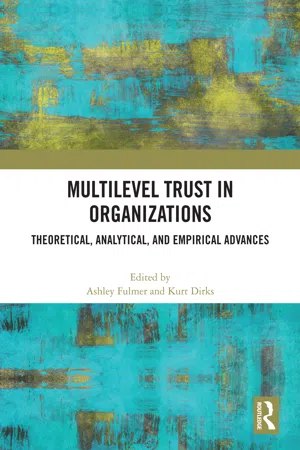M. Audrey Korsgaard, Jason Kautz, Paul Bliese, Katarzyna Samson and Patrycjusz Kostyszyn
Trust is a psychological state (Rousseau, Sitkin, Burt, & Camerer, 1998), commonly considered an attitude. Trust has been examined across multiple levels; the individual-level (e.g. Colquitt, Scott, & LePine, 2007; Mayer, Davis, & Schoorman, 1995; McAllister, 1995), the dyadic-level (e.g. Brower, Lester, Korsgaard, & Dineen, 2009; Dass & Kumar, 2011; De Jong & Dirks, 2012; Korsgaard, Brower, & Lester, 2015), the group-level (e.g. Meyerson, Weick, & Kramer, 1996; Simons & Peterson, 2000; Zand, 1972), the organisational-level (e.g. Miles & Snow, 1992), and through a multilevel lens (e.g. Costigan, Iiter, & Berman, 1998; Gupta, Ho, Pollack, & Lai, 2016). One consistency across all these levels is that trust changes. The nature of change typically occurs in one of two ways. First, theory suggests that trust can develop (or decline) as relationships between parties mature. That is, trust follows a predictable trajectory of formation, dissolution, and restoration, conditional on various individual differences and contextual factors (Fulmer & Gelfand, 2013; 2015). Second, trust may change as the conditions that contribute to or undermine trust vary. These variations in context may include interventions or responses to discrete events (Morgeson, Mitchell, & Liu, 2015) that lead to enduring patterns of change in trust. For example, an organisation may renege on an implied benefit, calling into question the fairness and integrity of the organisation’s leadership and undermine trust ( Ballinger & Rockmann, 2010). Such events can lead not only to a discrete change in trust but alter the trajectory: decelerating, accelerating or reversing the trend.
Both developmental and event-based changes require a dynamic, multilevel theoretical and methodological lens. We show that adopting a dynamic lens focusing on the trajectory of trust provides opportunities to formulate and test novel theoretical propositions that cannot be inferred from cross-sectional or two or three-wave longitudinal designs. We propose that by examining trajectories, we can see how the impact of events and changing conditions compound over time or, alternatively, dissipate over time. By examining trajectories, we can more accurately differentiate between (a) relatively trivial events that have an immediate but no lasting effects, (b) events that have a relatively small immediate effect but compound over time to produce meaningful effects, or (c) impactful events that have both an immediate and compounding effect over time.
The goals of this article are to bring the concept of the intra-individual trust trajectory to the forefront of trust theory, encourage the exploration of research questions that feature time in meaningful ways, and provide an analytic framework to help formulate and test hypotheses that focus on trust trajectories. We show that trust data are rarely modelled using statistical approaches that provide clear dynamic interpretations (for an exception see Fulmer & Gelfand, 2015), and we examine how such methodological constraints limit theory formulation and the generation of research questions. We then detail and illustrate an established but underutilised longitudinal analytic method (e.g. Bliese & Lang, 2016; Singer & Willett, 2003) that has the potential to test several compelling and theoretically critical questions about dynamic processes in the trust literature. As this approach is based on mixed effect modelling, it is well-situated to capture individual as well as higher-order effects on trust dynamics. We begin by examining how dynamics are conceptualised in trust theory and research, followed by an overview of how advances in longitudinal analytic methods can be used to test novel propositions regarding the dynamics of trust. Finally, we provide an illustrative example for testing discontinuities in trust trajectories and offer implications for future research.
Intra-Individual change as the basis of multilevel understanding
As noted, trust is a complex, multifaceted construct. It exists at multiple conceptual levels (i.e. individual, dyadic, group, and organisational), is influenced by the social and/or situational context (i.e. social dynamics establish structures that guide trust), and can refer to states as well as processes (i.e. acts as a cause, outcome, or moderator). Taken together, trust is a meso-level phenomena that incorporates psychological processes within group and situational contexts, and is shaped by organisational policies and procedures. As pointed out by Rousseau et al. (1998), trust originates within the individual. Trust can thus be conceptualised within a multilevel framework wherein individuals are nested within dyadic-, team-, and organisational-level processes.
Theory also suggests, however, that trust is a dynamic state, waxing and waning as individuals interact and events reinforce or undermine trust. The dynamics of trust suggests a more elemental level of nesting within the individual: individual-level trust varies across time. As such, our discussion of the dynamic nature of trust as a multilevel construct starts with a framework of intra-individual changes but incorporate a multilevel perspective to explore the influence of higher-order factors.
